At the much-anticipated annual agrobiodiversity fair, farmers preserve native crops by sharing seeds and showing off a bounty of corn and other culturally significant crops.
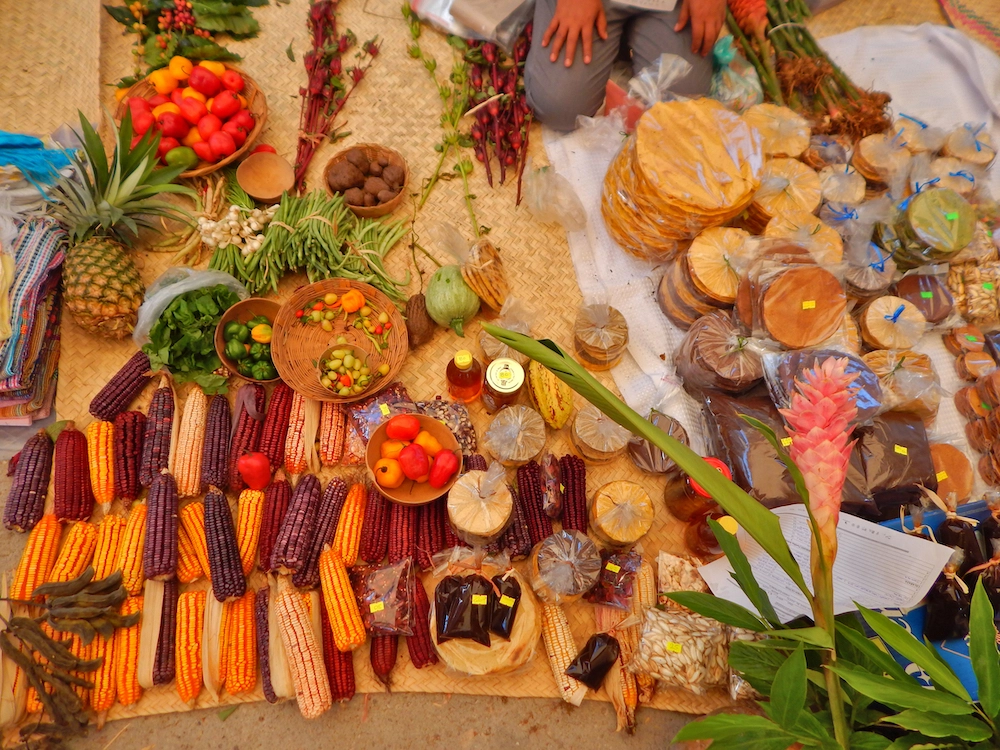
Anyone who’s spent time in Mexico can report firsthand on the country’s deep reverence for corn, that infinitely versatile and nutritive grain that forms the base of the country’s daily bread, the tortilla, as well as a multitude of other traditional foods. Much more than just a crop, corn has been a fundamental part of Mexican life since time immemorial, with the Mayan sacred text the Popol Vuh relating that the creator gods Tepeu and Gucumatz formed the first human beings from maíz, as corn is known in Spanish.
Here in Oaxaca, the southwestern Mexican state known for rich cultural traditions ranging from intricate artisan goods to vibrant music and dance, the veneration for corn is apparent when surveying some of the area’s favorite foods. You might greet your day here with a steaming mug of atole, a sweetened corn gruel akin to a thinned-out porridge; enjoy a midmorning snack of memelas, thick corn tortillas swiped with pork lard and a variety of other toppings; and, at dinnertime, crunch into a tlayuda, an oversized tortilla stuffed with mozzarella-like quesillo cheese and griddled over hot coals until crisp. And if, for some reason, the Oaxacan adoration of corn wasn’t glaringly obvious, a stroll through the area’s yearly Feria Estatal de la Agrobiodiversidad—the state fair of agrobiodiversity—clears the matter up in no time.
This much-anticipated daylong event, which aims to both promote and protect Oaxaca’s agricultural richness, takes place every year in late November or early December. This year, the fair opened its doors on Saturday, December 2, in the community of San Pablo de Mitla, located about an hour’s drive east of the capital, Oaxaca City. A multisensory celebration of local crops ranging from sweet potatoes to medicinal herbs to amaranth, the Fería naturally has a heavy presence of corn. This year, visitors to the fair—who range from foodie members of the public to agronomy students to biologists and more—were greeted by an elaborate arch bedecked in multicolored corn kernels and flowerlike dried husks, with a mosaic-style image depicting a woman with long braids emerging from an ear of corn.
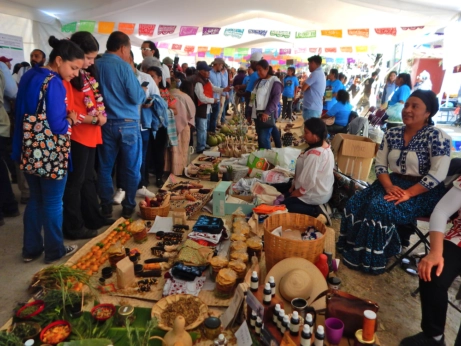
Visitors to the fair admire offerings from the mountainous Sierra Mixe region of Oaxaca. (Photo: Lauren Rothman)
Passing through the archway, visitors arrived under a big white tent where more than 500 farmers from across the state and a handful from out of state displayed their colorful, edible wares. Sprawled out on the ground atop well-worn petates (woven-fiber mats) or seated on low stools, the farmers showed off their hard-earned ears of corn, yes, but also laid out carefully arranged piles of smooth, shiny beans, bowls of bright red and yellow chile peppers, verdant heaps of string beans and many more crops. This year, according to to the Secretaría de Fomento Agroalimentario y Desarrollo Rural—the governmental body that’s part of a multigroup organizing committee that puts the fair together—more than 500 expositors belonging to 16 indigenous ethnic groups were present, bringing with them 35 of Mexico’s 64 native variants of corn alongside other important crops.
In Mexico, as in the rest of the modern world, biologically diverse traditional agriculture is increasingly being crowded out by hybrid and genetically modified crops that can withstand heavy applications of industrial herbicides and pesticides. For many millennia, the land of the milpa—an interdependent, mutually beneficial growing system of corn, beans, squash and the class of wild-growing greens collectively known as quelites—the country, since the so-called Green Revolution of the 1950s and 60s, has increasingly shifted to vast, chemical-dependent monocultures of crops, including corn, limes, papaya and single-species forests grown for harvesting timber.
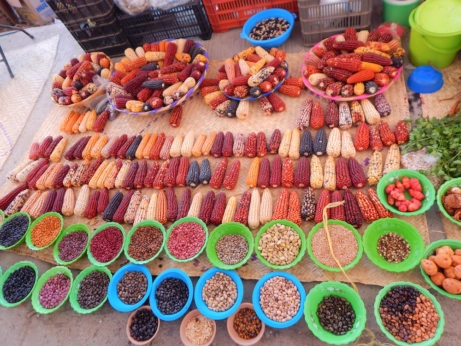
A kaleidoscope of native corn varieties, plus colorful beans in a range of shades. (Photo: Lauren Rothman)
The idea for the Fería, now in its 11th year, was born as a response to this ecological crisis, which necessarily endangers the existence of small-scale traditional crops that are more time consuming to grow and less lucrative to sell, according to Girmey López Martínez, an agricultural engineer and promoter of traditional agriculture. Each year, the fair unites a diverse group of farmers who continue to grow traditional Oaxacan crops even in the face of the rising tide of big ag, sharing their products with the public in order to help maintain culinary familiarity with them, as well as saving seeds to exchange them with other farmers they meet at the fair in an additional effort to maintain agricultural diversity in the region.
“The aim of the fair is to strengthen and maintain the biodiversity of the region’s gardens, milpas, coffee plantations and cacao plantations,” said Martínez in an interview a few days after the most recent edition of the fair, which he helped fundraise. In addition to an increasing dependence on monocropping in Oaxaca, Martínez cited factors such as the growth of the local ranching industry and the explosion of unsustainable ecotourism practices as additional pressures that endanger agricultural diversity in the region.
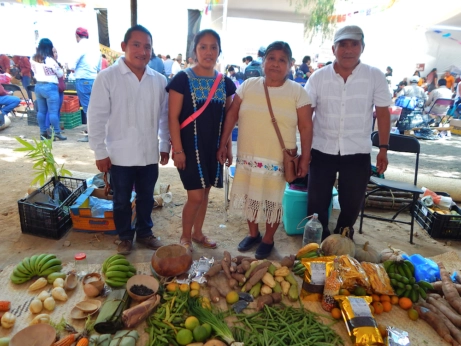
The display of husband-and-wife producers José Gregorio Justo and Reina Ramirez Ronquillo from the rainforested Chinantla region, which includes yucca root, fresh banana leaves, and chayote gourd. (Photo: Lauren Rothman)
For husband-and-wife producers José Gregorio Justo and Reina Ramirez Ronquillo from the rainforested Chinantla region of Oaxaca, continuing to grow the corn sown by their ancestors is of utmost importance. “We can’t lose the traditions we’ve had since the olden times,” Ronquillo said at the fair as she stood behind the couple’s abundant display of organically grown sugarcane, bananas, squashes, green beans, coffee, beans and several types of corn. “Where we live, lots of people are growing genetically modified corn. But we know that what we grow is better than that type of corn. And we’re taking care of the soil, too.”
Accompanied at her display by her daughter-in-law, Ronquillo added that farming in the old way takes future generations into consideration, too. “We don’t buy anything at the store,” she said. “Everything we eat, we grow. Lots of mothers and fathers today are buying their children sodas and chips, and it’s pure poison. Our grandchildren eat boiled chayotes, bananas, yucca; we make a fresh infused water to drink and it’s much healthier.”
Nearby, Maria de Jesús Fuentes attended to her display of panela, or raw sugar-sweetened tostadas made from native corn and flavored with additional ingredients such as cacao and grated coconut. Fuentes had traveled from the Mandimbo community close to the Oaxacan coast and, in addition to her prepared products, had in tow a variety of young fruit trees ranging from jackfruit to starfruit to mango. She explains that part of her work is saving the seeds from different types of fruit, both to trade with other farmers as well as to grow into trees that she sells.
“There are two major threats to criolla [native] seeds today,” said Fuentes. “One is the threat of all the GMO crops everyone is sowing. And the other is that the young people just don’t want to keep farming. Under both of these threats, species can go extinct. And that is why we save seeds.”
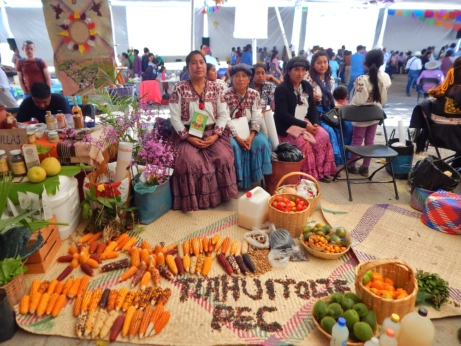
Women producers of Tlahuitoltepec, in the Sierra Mixe region, display corn (of course), plus prickly chayote and freshly fermented pulque drink, made from the tapped sap of the agave plant. (Photo: Lauren Rothman)
While many of the vendors adhere to organic practices, others continue to sow native crops but take advantage of the convenience offered by agrochemicals, such as one farmer from the mountainous La Cañada region who admitted to mixing commercial fertilizer in with goat manure.
Overall, Martínez noted, the majority of the expositors left this year’s fair feeling delighted with the event and the opportunity to exchange products, seeds and ideas with other growers as well as with the Oaxacan public. “This is our second year participating, and we really enjoy being here,” said Ronquillo from the Chinantla region. “It makes us happy to be able to offer the products that we grow.”
Raised by Mexicans on a small farm in Brownsville,Texas, I learned Spanish along with English. Family traveled all over Mexico in an Army surplus Jeep. Our first stop in every village was to the MERCADO where we would purchase indigenous foods such as Papas del Monte ,wild potatoes about the size of marbles. Many of these unusual foods we would take to a local restaurant where the cook would prepare them in the traditional way. Street vendors with BRACEROS, Hibaches, would would often prepair and sell native foods not seen in restaurants. I was not familiar with this fair, but… Read more »